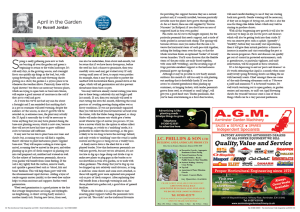
Spring is really gathering pace now as buds are bursting all over the garden and green is beginning to return to the wider landscape. It’s still early days, in the growing season, and overnight frosts can quickly nip things in the bud, but, with spring flowering bulbs and early flowering shrubs putting on a show, the garden is a joyous place to be whenever the weather allows. Famously, there will be ‘April showers’ but these are necessary because plants, which are trying to open buds or burst into bloom, will require a good amount of moisture in the soil if they are to swell and grow.
As I write this we’ve not had any rain for about a fortnight and I am reminded that anything that’s in a pot or container will need watering, despite the earliness of the season, or else it’s growth will be retarded or, in extreme cases, the plant may actually die. If April is unusually dry it will be necessary to water anything that you may have planted during the bare-root planting season, which is now over, because they will not yet have had time to grow sufficient roots to become self-sufficient.
It may now be too late to plant bare-root trees and shrubs but, assuming you can still find a supplier, there’s still time to plant herbaceous plants supplied bare-root. They will require soaking in water upon arrival, assuming they’ve arrived in the post, and either planting up in pots of fresh compost or planting out into well prepared soil, mulched and watered-in well. On the subject of herbaceous perennials, those in your garden will benefit from some feeding. If the soil is dry, lightly fork the surface, remove weeds, and sprinkle a general feed such as ‘blood, fish and bone’ fertiliser. This will help them grow well with the aforementioned April showers. Adding a layer of sterile organic matter (mulch) to the weed-free surface helps to retain moisture and suppress further weed germination.
Weed seed germination is a good pointer to the fact that average temperatures are rising, and daylengths are lengthening, so direct sowing hardy annuals is another timely task. Starting new lawns, from seed, can also be undertaken, from about mid-month, but be aware that if we have heavy downpours, before the seed has had a chance to germinate, then your carefully sown seed may get washed away. If only sowing small areas of lawn, to repair worn patches for example, then it may be possible to protect the seedbed with horticultural fleece, pinned down at the edges, which will aid germination and also prevent disturbance from birds or pets.
You may well have already started cutting your lawn due to there being a relatively dry and bright spell last month. If not, then you certainly will need to start cutting the lawn this month, following the usual provisos of avoiding mowing during either wet or frosty conditions. If you are particularly organised then you will have had your lawnmower serviced over the winter, with the blades being sharpened, as sharp blades will make cleaner cuts which give a better result whatever type of mower you possess. If you have a mower which has the option to either collect the mowings, or switch to a ‘mulching’ mode, it is preferable to collect the first mowings, as the grass is likely to be too long to leave the mowings behind, and only switch to ‘mulching’ once the sward is under control and the grass is being cut on a weekly basis.
A finely mown lawn is the ideal foil to a well planted border. Now that herbaceous perennials are well into growth, but not yet too advanced, it’s not too late to dig up a large clump and divide it up to make new plants to plug gaps in the border or to use elsewhere in your own garden, or to trade with other gardeners. The clump that you’ve dug up can be chopped up into relatively small divisions, as long as each has some shoots and some roots attached, as these will rapidly grow once replanted into prepared soil or pots of fresh compost. After replanting they will benefit from a thorough watering-in and, for those planted into garden soil, a good dose of general fertiliser.
While in the borders it is a good idea to start inserting plant supports before the perennials have got too tall. ‘Pea-sticks’ are the traditional favourite for providing this support because they are a natural product and, if correctly installed, become practically invisible once the plants have grown through them. As far as I know, these are still supplied by ‘Groves Nurseries’ (in Bridport) if you don’t have an area of coppiced hazel in your own garden!
Pea-sticks can be cut to the height required, for the particular perennial that needs support, and a circle of sticks pushed in around each clump. The spacing will become obvious once you realise that the aim is to weave the horizontal stems of each pea-stick together, arching the leading stems over the top, so that the whole structure forms an upturned ‘basket’ of loosely woven branches. You’ll soon discover that the flexible stems of the pea-sticks are easily fused together, with some deft ‘twiddling’, and the resulting cage of twigs provides excellent support as the herbaceous perennial grows up through it.
Although it may be possible to sow hardy annuals outdoors this month it’s still too early to risk planting out anything that it doubtfully hardy. If you have access to a heated greenhouse then planting up containers, or hanging baskets, with tender perennials grown from seed, or obtained as small ‘plugs’, will give you a good head start. Tender perennials, that you’ve been overwintering in a frost-free location, will need careful checking to see if they are starting back into growth. Gentle watering will be necessary, if they are in danger of drying out, and this is also the case for things like dahlia tubers which may well be starting to produce shoots.
With all this burgeoning new growth it will also be necessary to keep an eye out for pests and diseases which will also be getting back into their stride. If you can remove pests such as aphids (‘greenfly’ / ‘blackfly’) before they can really start reproducing, then it will give their natural predators a chance to increase in number and start controlling the pest as the season progresses. Pests and diseases can quickly get out of control in protected environments, such as greenhouses, so particular vigilance, and early intervention, will be required in those situations.
It’s a bit depressing to end on ‘pests and diseases’ so it’s worth reiterating that April is a month when some really lovely spring flowering shrubs are filling the air with heavenly scents. Chief amongst these are some of the early flowering viburnums such as Viburnum x juddii and numerous V. x burkwoodii varieties. It’s well worth venturing out to open gardens, or garden centres and nurseries, to sniff out April flowering shrubs for yourself because scent is one of those things which can be a very personal preference.




